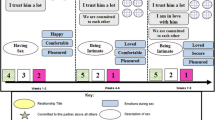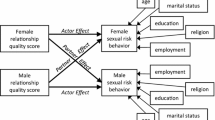Abstract
Behavioral and epidemiological studies report high risk for HIV among MSM couples. Over the last decade, studies have examined relationship dynamics associated with sexual risk for HIV. It is important to examine the impact this research has had on HIV prevention and what is still needed. We conducted a review of the literature focusing on relationship dynamics associated with sexual risk for HIV among MSM couples. Procedures used for this review were guided by the Preferred Reporting Items for Systematic Reviews and Meta-Analyses established to provide a framework for collecting, reviewing and reporting studies systematically (Mohler et al. in Ann Intern Med 151(4):264-269, 2009). We found that positive relationship dynamics are associated with less risk with partners outside the relationship, but were associated with greater odds of unprotected anal intercourse with primary partners. We also discuss other factors including sexual agreements about outside partners and make recommendations for next steps in HIV prevention research among MSM couples.
Resumen
Estudios conductuales y epidemiológicos informan alto riesgo de HIV entre parejas de MSM. En la última década, estudios han analizado la dinámica de relación asociado al riesgo sexual para el HIV. Es importante examinar el impacto de que esta investigación ha tenido en la prevención del HIV y lo que es necesario. Se realizó una revisión de la literatura centrada en la dinámica de la relación asociada a sexuales de riesgo para el VIH entre las parejas de HSH. Procedimientos utilizados para esta revisión fueron guiados por los elementos de información preferido para revisiones sistemáticas y metanálisis (PRISMA) establecido para proporcionar un marco para recolectar, revisar e informar estudios sistemáticamente (Mohler et al. in Ann Intern Med 151(4):264-269, 2009). Encontramos que dinámica de la relación positiva se asocian a menor riesgo con socios fuera de la relación, pero se asociaron con mayor probabilidad de relaciones sexuales anales sin protección (UAI) con los principales socios. También discutir otros factores incluyendo acuerdos sexuales sobre socios exterior y formular recomendaciones para próximos pasos en la investigación de la prevención del HIV entre parejas de MSM.

Similar content being viewed by others
References
CDC. HIV among gay and bisexual men: fact sheet. 2014.
Davidovich U, et al. Increase in the share of steady partners as a source of HIV infection: a 17-year study of seroconversion among gay men. AIDS. 2001;15(10):1303–8.
Goodreau SM, et al. What drives the US and Peruvian HIV epidemics in men who have sex with men (MSM)? PLoS One. 2012;7(11):e50522.
Sullivan PS, et al. Estimating the proportion of HIV transmissions from main sex partners among men who have sex with men in five US cities. AIDS. 2009;23(9):1153–62.
CDC, HIV Prevention: Progress to Date. 2013, Department of Health and Human Services: Atlanta, GA.
Karney BR, et al. A framework for incorporating dyads in models of HIV-prevention. AIDS Behav. 2010;14(2):189–203.
Moher D, et al. Preferred reporting items for systematic reviews and meta-analyses: the PRISMA statement. Ann Intern Med. 2009;151(4):264–9.
Appleby P, Miller L, Rothspan S. The paradox of trust for male couples: when risking is a part of loving. Pers Relationsh. 1999;6:81–93.
Darbes LA, Lewis MA. HIV-specific social support predicts less sexual risk behavior in gay male couples. Health Psychol. 2005;24(6):617–22.
Starks TJ, Gamarel KE, Johnson MO. Relationship characteristics and HIV transmission risk in same-sex male couples in HIV serodiscordant relationships. Arch Sex Behav. 2014;43(1):139–47.
Fergus S, et al. HIV risk and protection among gay male couples: the role of gay community integration. Health Educ Behav. 2005;32(2):151–71.
Fergus S, et al. Social support moderates the relationship between gay community integration and sexual risk behavior among gay male couples. Health Educ Behav. 2009;36(5):846–59.
Gorbach P. Transmission of STIs/HIV at the partnership level: beyond individual analyses. J Urban Health, 2003; 80(supplement 3):iii15–11125.
Mustanski BS, et al. HIV in young men who have sex with men: a review of epidemiology, risk and protective factors, and interventions. J Sex Res. 2011;48(2?3):218–53.
Nemoto T, et al. Social context of HIV risk behaviours among male-to-female transgenders of colour. AIDS Care. 2004;16(6):724–35.
Darbes LA, et al. Partner-provided social support influences choice of risk reduction strategies in gay male couples. AIDS Behav. 2012;16(1):159–67.
Darbes LA, et al. Sexual risk for HIV among gay male couples: A longitudinal study of the impact of relationship dynamics. Arch Sex Behav. 2014;43(1):47–60.
Eaton LA, et al. HIV transmission risk among HIV seroconcordant and serodiscordant couples: dyadic processes of partner selection. AIDS Behav. 2009;13(2):185–95.
Gamarel KE, et al. Personal or relational? Examining sexual health in the context of HIV serodiscordant same-sex male couples. AIDS Behav. 2014;18(1):171–9.
Hoff CC, et al. Relationship characteristics associated with sexual risk behavior among MSM in committed relationships. AIDS Patient Care STDs. 2012;26(12):738–45.
McNeal JL. The association of idealization and intimacy factors with condom use in gay male couples. J Clin Psychol Med Settings. 1997;4(4):437–51.
Mitchell JW, et al. Relationship factors associated with HIV risk among a sample of gay male couples. AIDS Behav. 2012;16(2):404–11.
Mitchell JW, Petroll AE. Factors associated with men in HIV-negative gay couples who practiced UAI within and outside of their relationship. AIDS Behav. 2013;17(4):1329–37.
Mitchell JW, Champeau D, Harvey SM. Actor-partner effects of demographic and relationship factors associated with HIV risk within gay male couples. Arch Sex Behav. 2013;42(7):1337–45.
Neilands TB, et al. Development and validation of the sexual agreement investment scale. J Sex Res. 2010;47(1):24–37.
Wagner GJ, Remien RH, Dieguez AC. Prevalence of extradyadic sex in male couples of mixed HIV status and its relationship to psychological distress and relationship quality. J Homosex. 2000;39(2):31–46.
Remien RH, Carballo-Dieguez A, Wagner G. Intimacy and sexual risk behaviour in serodiscordant male couples. AIDS Care. 1995;7(4):429–38.
Beougher SC et al. Risks worth taking: safety agreements among discordant gay couples. AIDS Care. 2012; 24(9):1071–7.
Beougher SC, et al. Past present: discordant gay male couples, HIV infection history, and relationship dynamics. J Gay Lesbian Soc Serv. 2013;25(4):379–98.
Huebner DM, et al. The impact of parenting on gay male couples’ relationships, sexuality, and HIV risk. Couple Fam Psychol. 2012;1(2):106.
Greene GJ, et al. Intimacy, monogamy, and condom problems drive unprotected sex among young men in serious relationships with other men: a mixed methods dyadic study. Arch Sex Behav. 2014;43(1):73–87.
Wagner GJ, Remien RH, Carballo-Dieguez A. “Extramarital” sex: is there an increased risk for HIV transmission? A study of male couples of mixed HIV status. AIDS Educ Prev. 1998;10(3):245–56.
Wu E, et al. Feasibility and promise of a couple-based HIV/STI preventive intervention for methamphetamine-using, black men who have sex with men. AIDS Behav. 2011;15(8):1745–54.
Beougher SC, Gómez W, Hoff CC. The couple as context: Latino gay male couples and HIV. Cult Health Sex. 2010;13(3):299–312.
Carballo-Diéguez A, et al. Unsafe sex in the primary relationships of Puerto Rican men who have sex with men. AIDS Behav. 1997;1(1):9–17.
Campbell CK, et al. Health, trust, or “Just Understood”: explicit and implicit condom decision-making processes among black, white, and interracial same-sex male couples. Arch Sex Behav. 2014;43(4):697–706.
Mitchell JW. HIV-negative and HIV-discordant gay male couples’ use of HIV risk-reduction strategies: differences by partner type and couples’ HIV-status. AIDS Behav. 2013;17(4):1557–69.
Parsons JT, Starks TJ. Drug use and sexual arrangements among gay couples: frequency, interdependence, and associations with sexual risk. Arch Sex Behav. 2014;43(1):89–98.
Kelley H, Thibaut J. Interpersonal relations: a theory of interdependence. New York: Wiley; 1978.
Rusbult C, Buunk B. Commitment processes in close relationships: an interdependence analysis. J Soc Pers Relationsh. 1993;10:175–204.
Rusbult CE, Van Lange PAM. Interdependence, interaction, and relationships. Annu Rev Psychol. 2003;54:351–75.
Cutrona CE, Russell D. The provisions of social relationships and adaptation to stress. In: Jones WH, Perlman D, editors. Advances in Personal Relationships. Greenwich: JAI Press; 1987. p. 37–67.
Hoff CC, Beougher SC. Sexual agreements among gay male couples. Arch Sex Behav. 2010;39(3):774–87.
Gomez AM, et al. Relationship dynamics as predictors of broken agreements about outside sexual partners: implications for HIV prevention among gay couples. AIDS Behav. 2012;16(6):1584–8.
Colfax GN, et al. Drug use and sexual risk behavior among gay and bisexual men who attend circuit parties: a venue-based comparison. JAIDS J Acquir Immune Defic Syndr. 2001;28(4):373–9.
Wilson PA, et al. Drug use, interpersonal attraction, and communication: situational factors as predictors of episodes of unprotected anal intercourse among Latino gay men. AIDS Behav. 2009;13(4):691–9.
Carrico AW. Substance use and HIV disease progression in the HAART era: implications for the primary prevention of HIV. Life Sci. 2011;88(21):940–7.
Carrico AW, et al. Affective correlates of stimulant use and adherence to anti-retroviral therapy among HIV-positive methamphetamine users. AIDS Behav. 2010;14(4):769–77.
Amaro H. Love, sex, and power: considering women?s realities in HIV prevention. Am Psychol. 1995;50(6):437–47.
Pulerwitz J, et al. Relationship power, condom use and HIV risk among women in the USA. AIDS Care. 2002;14(6):789–800.
Stephenson R, Finneran C. The IPV-GBM scale: a new scale to measure intimate partner violence among gay and bisexual men. PLoS One. 2013;8(6):e62592.
Author information
Authors and Affiliations
Corresponding author
Rights and permissions
About this article
Cite this article
Hoff, C.C., Campbell, C.K., Chakravarty, D. et al. Relationship-Based Predictors of Sexual Risk for HIV Among MSM Couples: A Systematic Review of the Literature. AIDS Behav 20, 2873–2892 (2016). https://doi.org/10.1007/s10461-016-1350-9
Published:
Issue Date:
DOI: https://doi.org/10.1007/s10461-016-1350-9




